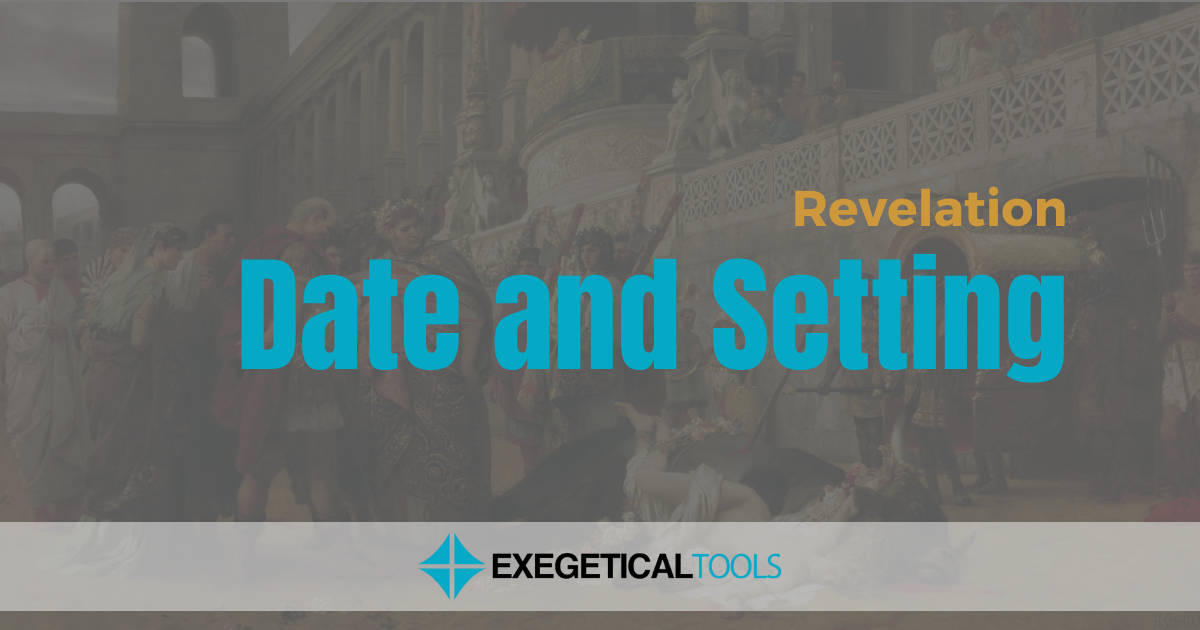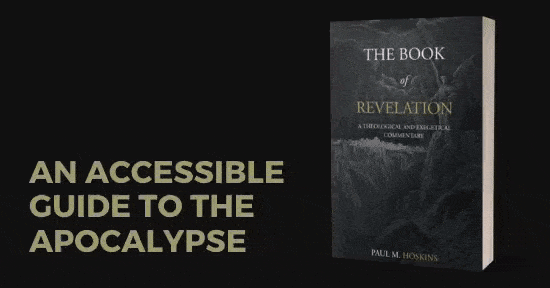
It is easier to describe some aspects of the setting for the book of Revelation than to pinpoint a date. In terms of setting, John locates his vision on the island of Patmos. According to Revelation 1:9, he is a “fellow partaker in the tribulation” and he is on Patmos “because of the word of God and the testimony of Jesus.” Taken together, interpreters generally think that these words are consistent with the testimony of Church Fathers that John is on Patmos, because he is in exile there.
Setting: Persecution and Temptations
Revelation 2-3 confirms that John is not the only Christian in Asia Minor who is experiencing persecution. Antipas, the “faithful witness,” has already been killed in Pergamum (2:13). The Christians at Smyrna and Philadelphia are experiencing opposition that is being instigated, at least in part, by Jews (2:9-10; 3:8-9). Persecution from without is not the only problem faced by these churches. They also face temptation from false teachers, including the Nicolaitans and especially Jezebel (2:6, 14-15, 20).
In general, they are facing temptations related to life in a world that is so often following the ways of the Beast and the Harlot, rather than the ways of God. The false teachers, like Jezebel, are encouraging them to tread a path of compromise, which will allow them to worship God and idols. This path would help them to conform to the expectations of their cultural setting and alleviate persecution. Jesus’ words to John consistently chart a different course. Jesus counsels the churches to repent of their sins and to chart a course of unwavering obedience to him. This course will prepare them to receive the rewards that Jesus promises to the conquerors in the seven letters, and which shine forth in the New Jerusalem (21:1-22:5).
Date: Nero, Domitian, or…
Such a characterization of Revelation’s setting does not provide any specific indications regarding the date for the book. Many interpreters try to find specific indications of the book’s date in the seven kings of Revelation 17:10 or the mention of the temple of God in Revelation 11:1. In both cases, these verses are only helpful for providing a specific date if they are interpreted in a specific way. The seven kings of Revelation 17:10 are helpful for dating the book only if they are meant to correspond to seven specific Roman Emperors.[1] If this equation does not hold true, as I argue in my commentary, then Revelation 17:10 has no bearing on the date of Revelation.[2]
Worship of the emperor, along with worship of other pagan gods, would have been an issue for Christians in Asia Minor, but it is not possible to provide solid evidence that the churches of Asia Minor suffered more persecution under Domitian than they did under Nero or any other Roman Emperor.[3] So, are there any factors in favor of a particular date, or range of dates, for Revelation?
As noted in the section on authorship, Irenaeus’s strong connections to Asia Minor and to Polycarp, who knew John the apostle, support the possibility that his information about the date of Revelation is accurate. In the midst of his treatment of the significance of 666, Irenaeus dates John’s visions to “the end of Domitian’s reign.”[4] Furthermore, Irenaeus says that John ministered in Asia Minor until he died during the reign of Roman Emperor Trajan (A.D. 98-117).[5] Due to Irenaeus’s testimony, many interpreters, ancient and modern, date Revelation during Emperor Domitian’s reign (A.D. 81-96).
Eusebius claims that John was in exile on Patmos, but was allowed to return to Ephesus after Domitian’s death.[6] Pliny’s letter to Trajan refers to people who claim that they were once Christians, but denied their faith in Christ as much as twenty years ago. As was the case in Pliny’s own time, at least some of these probably denied their faith under pressure to do so, including pressure from local officials, like Pliny. Therefore, Pliny provides at least some support for persecution of Christians in Asia Minor around A.D. 92.[7] Even so, persecution of Christians in Asia Minor could have been going on for a long time, as even the book of Acts shows (19:23-41).
Some supporters of John the apostle’s authorship, like Hort, think that it is unlikely that John wrote Revelation so late. The late date would make both the Gospel and Revelation products of a writer of “extreme old age.”[8] Hort thinks that placing a number of years between Revelation and the Gospel of John would help to account for their differences in Greek style.[9] He supports a date during the reign of Nero, a known persecutor of the church. Hort does admit, though, that the testimony of Irenaeus is important evidence in favor of a later date.[10]
Conclusion
In conclusion, the evidence from Irenaeus associates John the apostle with Ephesus up until the time of his death in the time of Trajan. It is not clear when John began his ministry in Ephesus.[11] Irenaeus claims that John saw the visions of Revelation at the end of Domitian’s reign. This would place the book somewhere in the 90’s, since Domitian’s reign ended in A.D. 96. For those who are inclined to doubt the accuracy of Irenaeus’s claim, it would be possible to date the book to any number of dates during John’s time in Ephesus.[12]
The contents of the book of Revelation do not point to a specific date, but to conditions that would have been in place during John’s entire ministry in Ephesus and Asia Minor. I am inclined to accept the dating of Irenaeus, but–in many commentaries, such as mine–nothing hinges upon the choice of a later versus an earlier date.[13]
This post is adapted with permission from Paul M. Hoskins, The Book of Revelation: A Theological and Exegetical Commentary (2017).
Notes
[1] Even if one holds to the view that the heads are related to Roman Emperors, it may not follow that one should expect to identify each head with a specific Roman Emperor (Koester, Revelation, 73, 76, 678, 691).
[2] Similarly, the legend of the return of Nero (Nero redivivus) is often associated with Rev. 17:10-11 and the dating of the book (Smalley, Thunder and Love, 44-45). This legend is not a helpful indicator for Rev.’s date if Rev. 17:10-11 is not alluding to this legend (see also Rev. 13:3, 14).
[3] Friesen, Imperial Cults and Apocalypse, 145-51; Koester, Revelation, 77. Koester notes that the evidence provided by Eusebius is not sufficient to support an increase in persecution in Asia Minor at the end of Domitian’s reign (Ecclesiastical History 3.17; 3.18.4-5; see also 3.19-3.20). According to Thompson, Eusebius is following the exaggerated assessment of Domitian’s cruelty that one finds in writings that appear after Domitian’s death. These writings want to cast Domitian as the evil foil to Trajan (Book of Revelation, ch. 6, esp. p. 115; also, 136-37).
[4] Irenaeus says, “For if it were necessary that his name should be distinctly revealed in this present time, it would have been announced by him who beheld the apocalyptic vision. For that was seen no very long time since, but almost in our day, toward the end of Domitian’s reign” (Against Heresies, 5.30.3; translation from ANF, vol. 1, 559-60). This quote occurs in Eusebius (Ecclesiastical History 3.18.2-3). Eusebius tries to be more specific. He appears to place Revelation in Domitian’s 15th year, that is, A.D. 95 (Ecclesiastical History 3.18.6).
[5] Irenaeus, Against Heresies 2.22.5 and 3.3.4.
[6] Ecclesiastical History 3.18.1, 3.20.10-11. He claims that the Roman Senate ordered those who were “unjustly banished” to be freed from exile (3.20.10, translation from NPNF2, vol. 1, 149). For other Church Fathers who agree with Eusebius, see Hort, Apocalypse, xv-xviii.
[7] Hemer, Letters to the Seven Churches, 10; Kiddle, Revelation, xl. Pliny was governor of Bithynia in Asia Minor when he wrote his famous letter to Trajan around A.D. 112 (112-20=92).
[8] Hort, Apocalypse, xl. Robinson estimates that John would have been quite old, somewhere around 90 years old, assuming that he was “as much as ten years younger than Jesus” (Redating the NT, 222). See also the comparable estimate by Carson and Moo (Introduction to the NT, 245). Maier provides his own estimate. If John was born around A.D. 10, then he could have been around 80 years old in A.D. 95 when he wrote Revelation (Offenbarung 1-11, 22).
[9] Hort, Apocalypse, xl. Here Hort says something quite similar to his contemporary, Westcott (John, lxxxvi).
[10] Hort, Apocalypse, xxxii. Hort provides further patristic references that support Irenaeus’ dating as well as a few sources that support a Nero date (ibid., xv-xix). Like Hort, Smalley is a proponent of an early date. However, he places the book of Revelation in the reign of Vespasian, just before the fall of the temple in A.D. 70 (Thunder and Love, 49).
[11] Hort, Apocalypse, xlii; Westcott, John, xxxiv.
[12] See Koester (Revelation, 79), who thinks that a date anywhere in A.D. 80-100 “seems most plausible.” For his comments on Irenaeus, see p. 74.
[13] For a list of interpreters who accept Irenaeus’s dating, see Maier, Offenbarung 1-11, 18.



2 comments